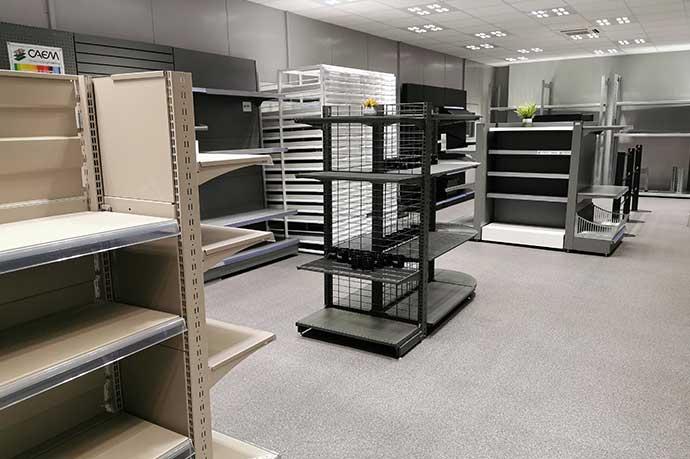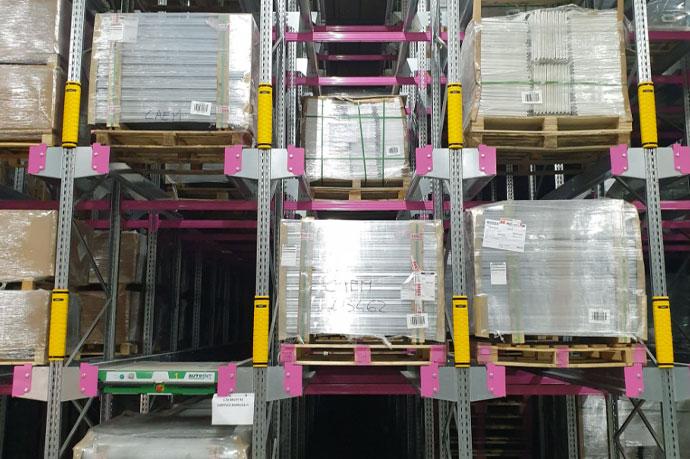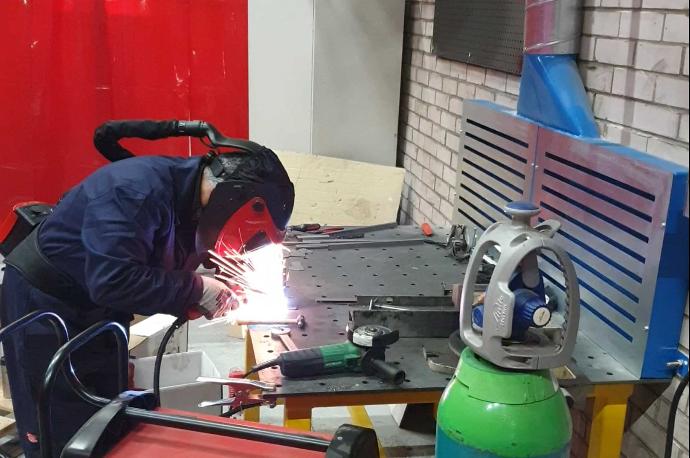https://www.caem.co.uk/ls9-longspan-shelving
Fulfillment Center Storage Racking: Optimizing Warehouse Efficiency
In the dynamic landscape of modern fulfillment operations, storage racking systems serve as the critical infrastructure that transforms spatial challenges into strategic advantages. With 59% of warehouses utilizing more than 90% of their available space, the selection and implementation of appropriate racking solutions has become more crucial than ever for operational success. This comprehensive guide explores the essential components, innovative technologies, and strategic considerations for implementing effective storage solutions in today's high-demand fulfillment environments.
Understanding Fulfillment Center Storage Systems
The Strategic Value of Optimized Storage Solutions
Storage racking in fulfillment centers represents more than mere organizational infrastructure—it's a fundamental driver of operational efficiency. With the warehousing market projected to reach $869.32 billion by 2025, businesses are increasingly recognizing how sophisticated racking systems directly impact order fulfillment speed, accuracy, and customer satisfaction.
Proper warehouse racking systems provide:
- Systematic organization of inventory for rapid retrieval
- Maximized vertical and horizontal space utilization
- Streamlined workflows that reduce picking times and labor costs
- Enhanced inventory visibility and control
- Scalability to accommodate business growth
Essential Components of High-Performance Racking Systems
The effectiveness of any storage rack system depends on its structural integrity and design specifications. Modern industrial racking systems feature:
- Heavy-duty frames constructed from precision-engineered steel capable of supporting specified load capacities
- Adjustable beams with safety locking mechanisms that prevent accidental dislodgment
- Wire decking or solid shelving options based on inventory characteristics
- Integrated safety features including load capacity indicators, impact protectors, and anti-collapse systems
- Modular designs that facilitate reconfiguration as inventory needs evolve
These foundational elements work together to create systems that safely support the 13,985 average SKUs handled in today's complex warehousing operations.
Industry-Standard Storage Solutions for Fulfillment Centers
With 89% of distribution centers using racking and shelving as their primary storage method, understanding the most widely-implemented systems is essential:
- Selective Pallet Racking: Offers 100% accessibility to all stored items, ideal for operations with diverse SKUs requiring frequent access
- Double-Deep Racking: Increases storage density by up to 40% compared to selective racking by storing pallets two-deep
- Push-Back Racking: Utilizes nested carts on inclined rails to maximize storage density while maintaining good selectivity
- Drive-In/Drive-Through Systems: Enables high-density storage of homogeneous products with capacity utilization rates of up to 75%
- Carton Flow Systems: Facilitates first-in-first-out (FIFO) inventory management with gravity-fed shelving
Each system addresses specific operational needs, from high-volume throughput to maximum space utilization.
Advanced Racking Solutions for Modern Warehousing Challenges
Pallet Racking: Customizable High-Capacity Storage
Pallet racking remains the backbone of warehouse storage solutions, offering versatility for diverse inventory profiles. These systems can be configured to support loads ranging from 2,000 to 4,500 pounds per pallet position, with beam lengths from 8 to 12 feet to accommodate various pallet sizes.
The latest innovations in pallet racking include:
- Structural steel uprights capable of withstanding impacts from material handling equipment
- Quick-adjust teardrop connections for rapid reconfiguration
- Integrated forklift guidance systems that reduce rack damage and improve operator efficiency
- Seismic-rated designs that meet zone-specific safety requirements
These features make pallet racking ideal for high-throughput environments where both storage density and accessibility are prioritized.
Cantilever Rack Systems for Long and Irregular Items
For businesses handling lumber, piping, furniture, or other non-standard items, cantilever racking provides unobstructed access and specialized support. These systems eliminate front columns that would otherwise interfere with storage and retrieval of lengthy products.
Key specifications include:
- Arms with capacities ranging from 500 to 3,000 pounds
- Column heights from 8 to 20 feet to maximize vertical space
- Adjustable arm spacing to accommodate various product dimensions
- Optional end stops and dividers for improved organization
Cantilever systems are particularly valuable in facilities handling construction materials or manufacturing components, where conventional racking would create access challenges.
Dynamic Storage Systems for Enhanced Picking Efficiency
The growing complexity of order fulfillment has driven adoption of dynamic storage systems that actively improve picking productivity. These solutions include:
Gravity Flow Racks:
- Utilize inclined roller tracks with a standard 4% slope
- Enable FIFO inventory management crucial for perishable or date-sensitive items
- Reduce picking travel time by up to 30% compared to static shelving
- Offer pick faces that can be replenished from the rear without interrupting picking operations
Carton Flow Systems:
- Feature wheel tracks or rollers that accommodate cartons weighing up to 50 pounds
- Automatically present products at the pick face, eliminating the need to reach into deep shelving
- Can be integrated with pick-to-light technology for error reduction
- Typically increase picking rates by 30-40% over static shelving solutions
These dynamic systems align perfectly with the industry trend toward greater order picking efficiency, particularly in e-commerce fulfillment scenarios.
Modular and Mobile Storage Solutions
With 87% of industry decision-makers planning warehouse extensions by 2024, flexibility in storage infrastructure has become a competitive advantage. Modular and mobile systems offer:
- Reconfigurable components that adapt to changing inventory profiles
- High-density mobile racking that eliminates fixed aisles, increasing storage capacity by up to 50%
- Scalable designs that grow with business needs without requiring complete system replacement
- Quick-deploy options for seasonal inventory surges or temporary storage requirements
These adaptable solutions prove particularly valuable for businesses with fluctuating inventory levels or those undergoing rapid growth phases.
Specialized Racking for Industry-Specific Requirements
Beyond standard configurations, specialized racking solutions address unique storage challenges:
- Textile Racking: Features hanging garment storage with capacities up to 150 pounds per linear foot
- Tire Racking: Designed with angled support arms to prevent tire deformation during storage
- Drum and Barrel Storage: Incorporates containment features for hazardous materials compliance
- Battery Racks: Constructed with acid-resistant finishes and charging station integration
- Cold Storage Systems: Built with specialized materials and finishes to withstand sub-zero environments
These purpose-built systems demonstrate how modern racking solutions have evolved to address specific industry requirements rather than forcing operations to adapt to standardized storage options.
Strategic Selection Criteria for Fulfillment Racking
Critical Evaluation Factors: Load Profiles, Space Utilization, and Operational Flow
Selecting optimal warehouse racking requires comprehensive analysis of:
Load Characteristics:
- Weight distribution (uniform vs. variable loads)
- Dimensions and shapes of stored items
- Handling requirements and access frequency
- Growth projections for inventory volumes
Space Optimization:
- Vertical clearance utilization (with 85% of distribution centers relying on forklifts to maximize vertical space)
- Aisle width requirements based on material handling equipment
- Clearances for sprinkler systems and lighting
- Floor loading capacity constraints
Operational Considerations:
- Order profile analysis (full pallet vs. case pick vs. piece pick)
- Throughput requirements and peak handling periods
- Inventory turnover rates by product category
- Material handling equipment specifications
By evaluating these factors comprehensively, facilities can select systems that deliver optimal performance for their specific operating conditions.
Customizing Solutions to Inventory Characteristics
The most successful racking implementations recognize that one-size-fits-all approaches rarely deliver optimal results. Modern fulfillment centers typically employ multiple racking types based on:
- Velocity Analysis: High-turnover items benefit from easily accessible locations in selective racking, while slow-moving inventory may be better suited to high-density storage
- Product Dimensions: Creating dedicated zones for non-standard items improves space utilization and operational efficiency
- Handling Requirements: Items requiring special handling equipment need compatible racking configurations
- Seasonal Fluctuations: Incorporating flexible storage areas that can adapt to seasonal inventory changes
This customized approach ensures that each product category is stored in the most efficient manner for its specific characteristics.
Investment Analysis: Long-Term Value vs. Initial Expenditure
When evaluating racking systems, comprehensive cost analysis should consider:
- Initial purchase and installation costs
- Expected lifespan and depreciation schedule
- Maintenance requirements and associated expenses
- Operational savings from improved efficiency
- Expansion capability and future adaptability
- Potential ROI improvements through increased storage capacity or faster throughput
Quality racking systems typically represent 15-20% of total warehouse infrastructure costs but can dramatically impact the efficiency of the entire operation over their lifespan of 15+ years when properly maintained.
Regulatory Compliance and Safety Standards
Ensuring racking systems meet or exceed safety requirements is non-negotiable. Key considerations include:
- Compliance with local building codes and seismic requirements
- Adherence to standards from organizations like RMI (Rack Manufacturers Institute) and ANSI
- Implementation of regular inspection protocols to identify damage or wear
- Clear marking of load capacities on all racking components
- Provision of adequate training for all staff interacting with racking systems
These safety measures protect both personnel and inventory while reducing liability exposure and potential operational disruptions.
Integrating Advanced Technologies with Racking Infrastructure
Automated Systems: Revolutionizing Storage Efficiency
With 77% of organizations planning or implementing automated warehouse systems, integration between racking and automation has become increasingly important. Modern automated solutions include:
- Automated Storage and Retrieval Systems (AS/RS) that maximize vertical space utilization up to 100 feet
- Shuttle systems that increase throughput by 25-40% compared to traditional picking methods
- Robotic picking systems that integrate directly with specialized racking designs
- Conveyor systems that connect storage zones for streamlined product movement
These technologies require racking systems specifically designed to interface with automated components, emphasizing the importance of forward-looking infrastructure planning.
IoT Integration: Smart Shelving for Real-Time Inventory Control
The Internet of Things (IoT) has transformed traditional racking into intelligent storage systems by incorporating:
- Weight sensors that provide real-time inventory level data
- RFID and barcode scanning integration for automated tracking
- Environmental monitors that ensure proper storage conditions
- Digital twins that enable virtual visualization of warehouse operations
These technologies work together to create unprecedented visibility into storage operations, supporting data-driven decision-making and reducing inventory discrepancies.
Advanced Software Solutions for Storage Optimization
Modern warehouse management systems offer sophisticated tools for racking optimization:
- Slotting optimization software that determines ideal product placement based on picking patterns
- Predictive analytics that forecast inventory requirements and suggest proactive reconfiguration
- 3D visualization tools for testing potential layout changes before physical implementation
- Integration with order management systems for dynamic allocation of picking priorities
These software solutions transform static racking installations into responsive systems that continuously adapt to changing operational requirements.
Implementation and Maintenance Best Practices
Professional Installation: Ensuring System Integrity
Proper installation is critical for racking performance and safety:
- Conduct thorough site assessment including floor quality evaluation and overhead obstruction mapping
- Create detailed installation drawings with precise measurements and component placements
- Ensure installation teams follow manufacturer specifications for component assembly
- Implement appropriate anchoring based on seismic requirements and load calculations
- Perform post-installation inspection and load testing before operational use
Professional installation by certified technicians ensures systems perform as designed and meet all safety requirements.
Proactive Maintenance Protocols
Regular maintenance extends system lifespan and prevents costly failures:
- Implement weekly visual inspections by warehouse staff
- Conduct quarterly documented inspections by trained safety personnel
- Schedule annual comprehensive evaluations by qualified racking specialists
- Address damage immediately with proper repair procedures
- Maintain detailed records of all inspections and repairs
These protocols help identify potential issues before they lead to system failures or safety incidents.
Scalability Strategies: Adapting to Business Growth
As operations expand, racking systems must evolve accordingly:
- Design initial installations with expansion capabilities
- Implement modular components that can be reconfigured or relocated
- Plan phased upgrades that minimize disruption to ongoing operations
- Consider leasing options for temporary capacity needs
- Develop clear replacement cycles for aging infrastructure
These forward-looking strategies ensure storage systems remain aligned with business requirements throughout their lifecycle.
CAEM's Distinctive Approach to Fulfillment Center Racking
Engineering Excellence and Customization Capabilities
CAEM's approach to warehouse racking systems emphasizes engineering precision and customization. Our design team works directly with clients to develop solutions that address their specific operational challenges rather than offering one-size-fits-all systems. This collaborative process includes:
- Comprehensive site assessment and workflow analysis
- Custom engineering for non-standard applications
- 3D modeling and simulation of proposed solutions
- Load testing and validation before full deployment
This rigorous design methodology ensures that each installation precisely matches client requirements for both current operations and future growth.
Innovation in Material Technology and System Design
CAEM distinguishes itself through continuous innovation in both materials and design approaches:
- High-strength steel formulations that increase load capacity while reducing component weight
- Advanced surface treatments that extend system lifespan in demanding environments
- Proprietary connection systems that improve structural integrity while simplifying installation
- Sustainable manufacturing processes that reduce environmental impact
These innovations deliver tangible benefits in terms of system performance, longevity, and total cost of ownership.
Implementation and Support Excellence
Beyond product quality, CAEM excels in implementation and ongoing support:
- Certified installation teams with specialized training
- Comprehensive documentation and training for client personnel
- Regular maintenance programs with detailed inspection protocols
- Responsive technical support throughout the system lifecycle
This comprehensive approach ensures that clients achieve maximum value from their racking investments through proper implementation and ongoing optimization.
Conclusion: Building the Foundation for Fulfillment Excellence
Effective storage racking systems form the essential infrastructure that enables fulfillment center success. By selecting appropriate racking solutions based on operational requirements, integrating advanced technologies, and implementing proper maintenance protocols, businesses can create highly efficient storage environments that drive competitive advantage.
As the warehousing sector continues its rapid evolution—with the market expected to grow to $869.32 billion by 2025—forward-thinking companies are recognizing that strategic investments in racking infrastructure deliver significant returns through improved throughput, reduced labor costs, and enhanced inventory control.
By partnering with experienced specialists like CAEM, businesses can develop comprehensive storage solutions that address current challenges while building the flexibility to adapt to future requirements. This strategic approach to warehouse racking transforms storage from a basic necessity into a powerful competitive advantage in today's demanding fulfillment landscape.
https://www.caem.co.uk/ls9-longspan-shelving





